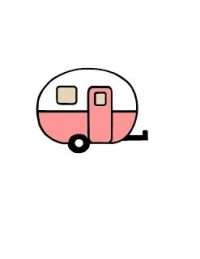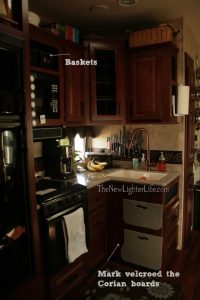It is funny all the differences to be found in living in a camper versus living in a normal home.
Up here in South Dakota, we bought humidifiers the first year we were here and living in our sticks and bricks home. Near-constant heating of the dry winter air made it a necessity.
In the camper, it’s SO much different. Here we have humidity and too much of it. I guess all these humans breathing, the moisture from cooking, and the heat going in such a small space completely changes the dynamics. Dramatically.
It’s important that you reduce humidity in a camper as much as possible.
As we enter our first winter in the camper, we’re faced with trying to reduce the humidity in our space.
Window Design. I’m thinking this is a newer design on the windows for RVs but our big windows in our living/dining/kitchen area have little itty bitty holes for the condensation to drip out of. Not all of the windows have these holes so we have to be sure to wipe any water out of the “trough”, where it collects. Also, the water can freeze so that’s something to watch out for too.
Venting.
Cooking Fan. When I cook, I make sure the vent is on. (important to do anyway because of the propane)
Windows. Sometimes we need to crack the windows because the condensation just isn’t letting it up. The camper heats up quickly, but it also cools down quickly.
Bathroom & Ceiling Vent. Not as easily accessible (at least our bathroom one is) but this also helps and is an option.
Dehumidifiers. I read the reviews on Amazon, and we purchased an Eva Dry small humidifier. It doesn’t seem to be able to keep up with the humidity but at least it is doing something. The jury is still out on whether we like this one or not. We may need to try another location and see if it draws out the moisture better.
 Moisture Absorbing Beads. We have NOT tried this but we have read about people using a product such as DampRid to absorb the moisture. With our little ones, we’re leaning away from doing this just yet. Seriously, it’s hard enough keeping the dog food and water in their respective bowls.
Moisture Absorbing Beads. We have NOT tried this but we have read about people using a product such as DampRid to absorb the moisture. With our little ones, we’re leaning away from doing this just yet. Seriously, it’s hard enough keeping the dog food and water in their respective bowls.
Plastic Window Insulation. We have NOT done this one either, but reportedly plasticizing the windows helps with insulating the warm indoor air from the cold window (thus reducing the condensation). Since the temperature fluctuates so much here, we want to be able to open the windows so we’ve been dragging our feet on this one.
Dry Towel. Oh yeah! We’re high-tech and use a towel to wipe the condensation off. It collects again, but at least it wipes up the excess.
So those are the ways we’ve found to reduce the condensation on the windows. It’s not a horrible issue, just one more thing we deal with difficulties in the camper.
Any experienced RVers or smart ones out there have more ideas, I’d love to hear them!









We have a whole house humidifier and we put plastic on our windows to help with condensation too! I wonder how this winter will compare with future winters since it has been unusually warm??
It’s a delicate balance…I’m hoping the unusually warm sticks around.
Fascinating. This would never have occurred to me!
I just discovered your site today and it has helped me SOOO much, especially this post!! I’m living in a 5th wheel with my boyfriend and my dog while I attend school and our biggest problem is the moisture! (It doesn’t help that we are on the coast either.) I’m definatly going to invest in a humidifier and the moisture absorbing beads in hopes that it will help reduce the condensation and the tiny bit of mold buildup I keep coming across in varies knooks and crannies. I have also been trying to convince my boyfriend to let me do some renovation/remodeling things, so hopefully by showing him your posts he will understand that it can be done without having to pay for it to bed one professionally.
Thanks!!
So glad it could help you Kaelie! (I’m sure it was a typo but just make sure you get a DEhumidifier – :)) To this day, I’m amazed at the transformation our camper took through the remodel. It is entirely possible for very little money and just a little elbow grease!
I can confirm that I have tried the moisture absorbing beads and they work almost like magic. You do have to remember to empty the water reservoir regularly, and the beads need changing from time to time, but I’ve been quite impressed by just how much water they attract.
For 2 years I have used “Himilayan Salt Rocks” in little salsa dishes placed all over my travel trailer. They work exceptionally well and are reusable by simply poring the water out when they fill up. I place on in every cupboard and closet and place them on counters. I have one dish by every window and there is almost no water on the single-pane-windows. The humidity stays around 40-50% with the help of a dehumidifier and heat. The best part is “Himilayan Salt Rocks” are non-toxic and won’t hurt my dog. Just my 2 cents, ask any questions and I’ll gladly answer.
We did this too. But we just bought rock salt at Lowes. The kind you use to salt your sidewalk. We poured them in some cheap strainers. Sat them over some cheap ziplock containers. We had to empty the containers regularly but they worked well. We also put charcoal in tin pans and hid them under the couch and bed. It helps remove odors. For some reason when the moisture rolled down the walls into the carpet it made formaldehyde odors that smell like cat pee. We also put plastic over the windows and used a large area dehumidifier. Leather towels that you buy at auto parts store for drying your car work well for absorbing water and not ending up with a pile of sopping wet towels. Wring it out and let it dry and you’re good for the next time